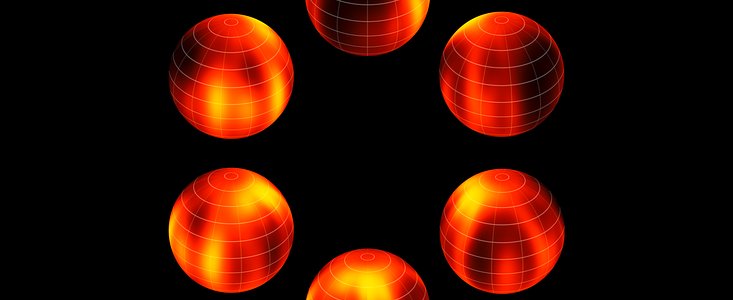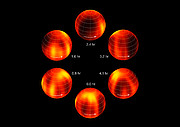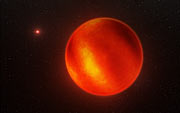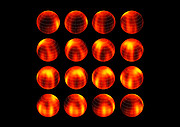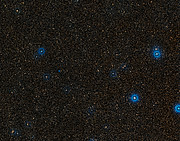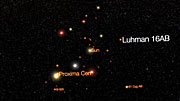Press Release
First Weather Map of Brown Dwarf
ESO’s VLT charts surface of nearest brown dwarf
29 January 2014
ESO's Very Large Telescope has been used to create the first ever map of the weather on the surface of the nearest brown dwarf to Earth. An international team has made a chart of the dark and light features on WISE J104915.57-531906.1B, which is informally known as Luhman 16B and is one of two recently discovered brown dwarfs forming a pair only six light-years from the Sun. The new results are being published in the 30 January 2014 issue of the journal Nature.
Brown dwarfs fill the gap between giant gas planets, such as Jupiter and Saturn, and faint cool stars. They do not contain enough mass to initiate nuclear fusion in their cores and can only glow feebly at infrared wavelengths of light. The first confirmed brown dwarf was only found twenty years ago and only a few hundred of these elusive objects are known.
The closest brown dwarfs to the Solar System form a pair called Luhman 16AB [1] that lies just six light-years from Earth in the southern constellation of Vela (The Sail). This pair is the third closest system to the Earth, after Alpha Centauri and Barnard's Star, but it was only discovered in early 2013. The fainter component, Luhman 16B, had already been found to be changing slightly in brightness every few hours as it rotated — a clue that it might have marked surface features.
Now astronomers have used the power of ESO's Very Large Telescope (VLT) not just to image these brown dwarfs, but to map out dark and light features on the surface of Luhman 16B.
Ian Crossfield (Max Planck Institute for Astronomy, Heidelberg, Germany), the lead author of the new paper, sums up the results: “Previous observations suggested that brown dwarfs might have mottled surfaces, but now we can actually map them. Soon, we will be able to watch cloud patterns form, evolve, and dissipate on this brown dwarf — eventually, exometeorologists may be able to predict whether a visitor to Luhman 16B could expect clear or cloudy skies.”
To map the surface the astronomers used a clever technique. They observed the brown dwarfs using the CRIRES instrument on the VLT. This allowed them not just to see the changing brightness as Luhman 16B rotated, but also to see whether dark and light features were moving away from, or towards the observer. By combining all this information they could recreate a map of the dark and light patches of the surface.
The atmospheres of brown dwarfs are very similar to those of hot gas giant exoplanets, so by studying comparatively easy-to-observe brown dwarfs [2] astronomers can also learn more about the atmospheres of young, giant planets — many of which will be found in the near future with the new SPHERE instrument that will be installed on the VLT in 2014.
Crossfield ends on a personal note: “Our brown dwarf map helps bring us one step closer to the goal of understanding weather patterns in other solar systems. From an early age I was brought up to appreciate the beauty and utility of maps. It's exciting that we're starting to map objects out beyond the Solar System!”
Notes
[1] This pair was discovered by the American astronomer Kevin Luhman on images from the WISE infrared survey satellite. It is formally known as WISE J104915.57-531906.1, but a shorter form was suggested as being much more convenient. As Luhman had already discovered fifteen double stars the name Luhman 16 was adopted. Following the usual conventions for naming double stars, Luhman 16A is the brighter of the two components, the secondary is named Luhman 16B and the pair is referred to as Luhman 16AB.
[2] Hot Jupiter exoplanets lie very close to their parent stars, which are much brighter. This makes it almost impossible to observe the faint glow from the planet, which is swamped by starlight. But in the case of brown dwarfs there is nothing to overwhelm the dim glow from the object itself, so it is much easier to make sensitive measurements.
More information
This research was presented in a paper, “A Global Cloud Map of the Nearest Known Brown Dwarf”, by Ian Crossfield et al. to appear in the journal Nature.
The team is composed of I. J. M. Crossfield (Max Planck Institute for Astronomy [MPIA], Heidelberg, Germany), B. Biller (MPIA; Institute for Astronomy, University of Edinburgh, United Kingdom), J. Schlieder (MPIA), N. R. Deacon (MPIA), M. Bonnefoy (MPIA; IPAG, Grenoble, France), D. Homeier (CRAL-ENS, Lyon, France), F. Allard (CRAL-ENS), E. Buenzli (MPIA), Th. Henning (MPIA), W. Brandner (MPIA), B. Goldman (MPIA) and T. Kopytova (MPIA; International Max-Planck Research School for Astronomy and Cosmic Physics at the University of Heidelberg, Germany).
ESO is the foremost intergovernmental astronomy organisation in Europe and the world's most productive ground-based astronomical observatory by far. It is supported by 15 countries: Austria, Belgium, Brazil, Czechia, Denmark, France, Finland, Germany, Italy, the Netherlands, Portugal, Spain, Sweden, Switzerland and the United Kingdom. ESO carries out an ambitious programme focused on the design, construction and operation of powerful ground-based observing facilities enabling astronomers to make important scientific discoveries. ESO also plays a leading role in promoting and organising cooperation in astronomical research. ESO operates three unique world-class observing sites in Chile: La Silla, Paranal and Chajnantor. At Paranal, ESO operates the Very Large Telescope, the world's most advanced visible-light astronomical observatory and two survey telescopes. VISTA works in the infrared and is the world's largest survey telescope and the VLT Survey Telescope is the largest telescope designed to exclusively survey the skies in visible light. ESO is the European partner of a revolutionary astronomical telescope ALMA, the largest astronomical project in existence. ESO is currently planning the 39-metre European Extremely Large optical/near-infrared Telescope, the E-ELT, which will become “the world's biggest eye on the sky”.
Links
Contacts
Ian Crossfield
Max Planck Institute for Astronomy
Heidelberg, Germany
Tel: +49 6221 528 406
Email: ianc@mpia.de
Richard Hook
ESO Public Information Officer
Garching bei München, Germany
Tel: +49 89 3200 6655
Cell: +49 151 1537 3591
Email: rhook@eso.org
About the Release
| Release No.: | eso1404 |
| Name: | Luhman 16B, WISE J104915.57-531906.1 |
| Type: | Milky Way : Star : Type : Brown Dwarf |
| Facility: | Very Large Telescope |
| Instruments: | CRIRES |
| Science data: | 2014Natur.505..654C |

